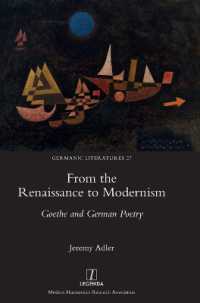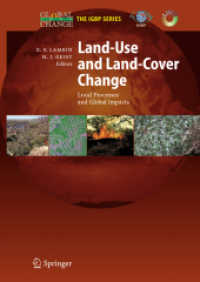- ホーム
- > 洋書
- > 英文書
- > History / World
Full Description
From Hispalis to Ishbiliyya: The ancient port of Seville, from the Roman Empire to the end of the Islamic period (45 BC - AD 1248) focuses on the history and development of the ancient port of Seville, which is located in the lower Guadalquivir River Basin, Spain. This unique study is important because, despite its commercial importance, little has been known about the port, and so the purpose was to examine the topography, layout, and facilities of the ancient port of Seville, their history and development from approximately the 1st c. BC to about the 13th c. AD. This longue durée study was conducted adopting a holistic and interdisciplinary approach by examining a diverse range of information (historical, archaeological and scientific), a maritime archaeological perspective as well as a diachronic study of three different historical periods (Roman, Late Antique, Islamic). As a result, it has been possible to offer a description of the construction, development, and demise of the port. The study was one of the first comprehensive studies of an ancient port in Spain and one of the first to be conducted in a combined holistic and diachronic manner in Europe. This methodology has produced significant results not obtained with other simpler approaches, thus serving as a model for studies of other archaeological sites, especially those in relation with maritime or riverine culture.
Contents
List of Figures ;
List of Tables ;
Acknowledgments ;
Foreword by David Blackman and Simon Keay ;
Foreword by Juan Antonio Quirós Castillo ;
Chapter 1 Introduction ;
Chapter 2 Methodology and scope of the research ;
Approaches for studying antiquity: maritime archaeology ;
Defining and justifying the geographical area: the Baetica Region ;
Defining and justifying the chronological scope: 45 BC - AD 1248 ;
Defining and justifying the study of ports ;
Mediterranean maritime trade routes and ships' cargoes ;
The study of shipwrecks in the Mediterranean ;
The use of palaeo-sciences for the study of ancient ports ;
Defining and justifying the organization of chapters ;
Chapter 3 The Roman period: the port of Hispalis ;
Geomorphology of the Guadalquivir Basin and River ;
Ancient navigation in the Lacus Ligustinus and the Baetis River ;
The geographical and topographical context of ancient Seville ;
Palaeo-hydromorphology of the Guadalquivir in the area of Seville ;
Textual evidence for the port of Hispalis ;
Epigraphic evidence for the port of Hispalis ;
Exports from Hispalis and the ships that carried them ;
Direct archaeological evidence for the port of Hispalis ;
Indirect archaeological evidence for the port of Hispalis ;
Concluding remarks on the Roman port of Hispalis ;
Chapter 4 Seville during the Late Antique period ;
Hispalis at the twilight of antiquity ;
The archaeological evidence of Hispalis during Late Antiquity ;
The Baetis River during Late Antiquity ;
The port of Hispalis during Late Antiquity ;
Discussion: was Seville controlled by Byzantium? ;
Chapter 5 Seville after the Umayyad conquest in AD 712 ;
Ishbiliyya: a new beginning (historical background) ;
The archaeological findings from the Islamic period at Plaza Nueva ;
The al-wādi al-kabīr during the Islamic period ;
The two ports of Ishbiliyya: new challenges and relocation ;
Chapter 6 Conclusions ;
References








